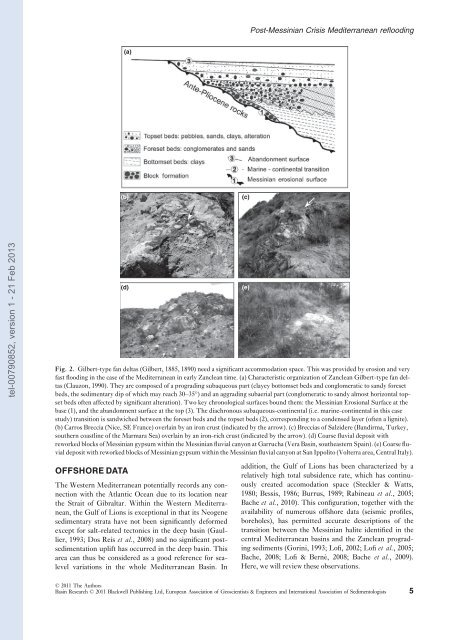Quantification des flux sédimentaires et de la subsidence du bassin ...
Quantification des flux sédimentaires et de la subsidence du bassin ...
Quantification des flux sédimentaires et de la subsidence du bassin ...
You also want an ePaper? Increase the reach of your titles
YUMPU automatically turns print PDFs into web optimized ePapers that Google loves.
tel-00790852, version 1 - 21 Feb 2013<br />
(a)<br />
OFFSHORE DATA<br />
(b) (c)<br />
(d) (e)<br />
Fig. 2. Gilbert-type fan <strong>de</strong>ltas (Gilbert, 1885, 1890) need a significant accommodation space. This was provi<strong>de</strong>d by erosion and very<br />
fast flooding in the case of the Mediterranean in early Zanclean time. (a) Characteristic organization of Zanclean Gilbert-type fan <strong>de</strong>ltas<br />
(C<strong>la</strong>uzon, 1990). They are composed of a prograding subaqueous part (c<strong>la</strong>yey bottoms<strong>et</strong> beds and conglomeratic to sandy fores<strong>et</strong><br />
beds, the sedimentary dip of which may reach 30–35°) and an aggrading subaerial part (conglomeratic to sandy almost horizontal tops<strong>et</strong><br />
beds often affected by significant alteration). Two key chronological surfaces bound them: the Messinian Erosional Surface at the<br />
base (1), and the abandonment surface at the top (3). The diachronous subaqueous-continental (i.e. marine-continental in this case<br />
study) transition is sandwiched b<strong>et</strong>ween the fores<strong>et</strong> beds and the tops<strong>et</strong> beds (2), corresponding to a con<strong>de</strong>nsed <strong>la</strong>yer (often a lignite).<br />
(b) Carros Breccia (Nice, SE France) over<strong>la</strong>in by an iron crust (indicated by the arrow). (c) Breccias of Salzi<strong>de</strong>re (Bandirma, Turkey,<br />
southern coastline of the Marmara Sea) over<strong>la</strong>in by an iron-rich crust (indicated by the arrow). (d) Coarse fluvial <strong>de</strong>posit with<br />
reworked blocks of Messinian gypsum within the Messinian fluvial canyon at Garrucha (Vera Basin, southeastern Spain). (e) Coarse fluvial<br />
<strong>de</strong>posit with reworked blocks of Messinian gypsum within the Messinian fluvial canyon at San Ippolito (Volterra area, Central Italy).<br />
The Western Mediterranean potentially records any connection<br />
with the At<strong>la</strong>ntic Ocean <strong>du</strong>e to its location near<br />
the Strait of Gibraltar. Within the Western Mediterranean,<br />
the Gulf of Lions is exceptional in that its Neogene<br />
sedimentary strata have not been significantly <strong>de</strong>formed<br />
except for salt-re<strong>la</strong>ted tectonics in the <strong>de</strong>ep basin (Gaullier,<br />
1993; Dos Reis <strong>et</strong> al., 2008) and no significant postsedimentation<br />
uplift has occurred in the <strong>de</strong>ep basin. This<br />
area can thus be consi<strong>de</strong>red as a good reference for sealevel<br />
variations in the whole Mediterranean Basin. In<br />
Post-Messinian Crisis Mediterranean reflooding<br />
addition, the Gulf of Lions has been characterized by a<br />
re<strong>la</strong>tively high total subsi<strong>de</strong>nce rate, which has continuously<br />
created accomodation space (Steckler & Watts,<br />
1980; Bessis, 1986; Burrus, 1989; Rabineau <strong>et</strong> al., 2005;<br />
Bache <strong>et</strong> al., 2010). This configuration, tog<strong>et</strong>her with the<br />
avai<strong>la</strong>bility of numerous offshore data (seismic profiles,<br />
boreholes), has permitted accurate <strong><strong>de</strong>s</strong>criptions of the<br />
transition b<strong>et</strong>ween the Messinian halite i<strong>de</strong>ntified in the<br />
central Mediterranean basins and the Zanclean prograding<br />
sediments (Gorini, 1993; Lofi, 2002; Lofi <strong>et</strong> al., 2005;<br />
Bache, 2008; Lofi & Berné, 2008; Bache <strong>et</strong> al., 2009).<br />
Here, we will review these observations.<br />
© 2011 The Authors<br />
Basin Research © 2011 B<strong>la</strong>ckwell Publishing Ltd, European Association of Geoscientists & Engineers and International Association of Sedimentologists 5

















